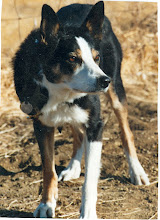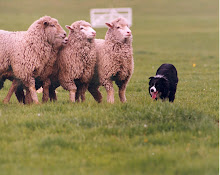Stuart Walton, in his Int'l Sheepdog News article on judging ["A Topic for Conversation - Judging," Jan/Feb 2010] makes the very valid point that the work of the dog must lie at the heart of the rules for judging trials, and of judging itself; and he gives excellent examples to support this thesis, such as the need to judge the fetch line from the point of balance wherever the dog may find it. But he departs from this standard in a couple of critical assertions he makes about the state of judging standards, and in his general tendency to exaggerate the weight of purely formal rules. Apart from the written rules, a large undergrowth of customary practice, rooted in practical shepherding, has grown up over many years, which informs, enlarges and indeed enriches the judging of trials. And so, in my view, judges must be allowed the discretion to apply such collective experience, albeit within the framework of the rules.
Mr Walton asks, for instance, “…why do handlers set their dogs off 3, 4, 5 or more yards from them and not think they should be penalized” when the rule states that the dog must stand close to the handler? The answer: because if the outrun is especially long, setting the dog up in this way tells it to go long and deep; setting the dog up flush by the handler’s side tells the dog to go short and tighter, in order to be in proper contact with the sheep, which if done in the case of a long outrun would require, in many cases, redirection, and therefore point loss. In other words, there’s a practical reason for doing so. That being said, the practice should not be abused, and a rule of thumb in the U.S. is that the limit should not exceed 48”, the length of a standard crook. The handler could then be penalized for setting the dog to go long when the outrun is modest, or if the dog were positioned beyond the length of a crook in the case of a long outrun. Judges could exercise legitimate discretion in the matter, just as they do, say, in judging the shape of an outrun.
Similarly, Mr Walton remarks that as the rules say nothing about holding shed sheep to the judge’s satisfaction, “so in my mind as long as the shed has occurred, I will judge it accordingly.” But surely the shed occurs only when the dog takes control of the shed sheep, and so the issue is: at what moment does this occur? That determination should be left to the judge. Some allow the dog merely to hold the sheep by facing them directly; some require that it turn their heads as well; others require that the dog wears them away a short distance; and still others demand that the dog drives them off for a long interval. All of these methods of demonstrating control are legitimate and should fall within the general rule. All that should be required is that the judge explains at a handlers’ meeting what his or her standard will be, and that s/he remains consistent in applying it, even where no handlers' meeting is held prior to trial. In such a way, customary practices, rooted in practical shepherding, may be integrated with the formal rules, which cannot in themselves encompass the great variation in nuances of interpretation that different judges may rightly render.
For this reason, we in the U.S.A. rely on judging guidelines, rather than rules, which set forth the range of points deducted for given faults, according to the standards used by a sample of highly experienced judges. Even with such latitude, however, it is possible for judges to err (they are not infallible). Handlers cannot of course see precisely what the judge sees, but most who are experienced trialing can calculate approximately what their scores should be. If honest about the faults of their runs, their scores should not deviate dramatically from the judge’s, however much they might differ in detail. When they do, the fault, more than likely, lies in the judging. Sometimes, too, serious errors in judging are obvious to spectators. And judges ought to be held accountable, either by formal protest from the handler, if the outcome at stake is significant, or by public comment of one sort or another.
One can recall a famous (and successful) protest launched at Meeker many years ago, by the late Ralph Pulfer, in his day a great icon of the sport in the U.S., when he and other handlers observed the set-out crew carrying back a sheep, lost by the dog to the holding pen on the first leg of a double gather, in order to rejoin it with the other nine so that the run might continue! For public comment, besides what one might read in a trial report, see the link below to three semi-final runs at the 2007 Welsh National Final in which the announcer cannot refrain from questioning the failure of judges to point the lift, as well as commentary on the scoring in other phases of work (the video gives a view from the judges’ perspective and so carries conviction): http://horseandcountry.tv/episode/come-bye-2007-episode-12. Might this make the case for instant video replay of contested judges’ decisions at trial, as in other sports?
Handlers may benefit, of course, by judging when they are invited, as Mr Walton rightly states. But those who judge with some regularity would also gain by trialing regularly. Skill in judging, after all, is really forged in the first instance by the repeated handling of a dog on the trial course, and its sharpness is further maintained by continuing to run a dog, however broadly experienced the judge. How many respected judges, once revered for their skills as handlers, have in fact retired from the trial course? One might legitimately wonder how well they’ve retained their judging skills.
Albion Urdank
Nuevo, CA USA
Albion

at Sonoma Sheepdog trial 2008
Blazing Tessa

at the old Coalinga, CA Sheepdog trial
ISN sheepdog trial reports by Albion
research article on sheepdog trials
"The Rationalisation of Rural Sport: British Sheepdog Trials, 1873-1946," Rural History: Economy, Society, Culture, 17, 1 (Apr 2006), Pp. 65-82. See for download : http://info.piercecollege.edu/departments/history/aurrs10.pdf .
Saturday, February 27, 2010
Subscribe to:
Posts (Atom)


